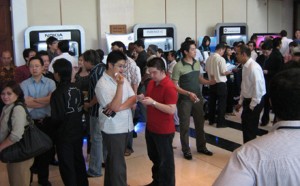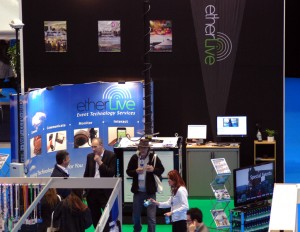Few things in life are as cut and dry as Sinatra vs Gaga or Apple vs Microsoft. The recent industry activity campaigning for free Wi-Fi at venues is a good example of something which should be straight forward, but is in fact a little more complicated.
The ABPCO (Association of British Professional Conference Organisers) recently announced securing more than 100 signatures for its campaign to bring free Wi-Fi to major event venues across the UK. This is a great campaign and should help focus the minds of venues who overcharge for basic access to the internet. Whilst I support the movement I find myself sympathetic to the venues who now find themselves between a rock and a hard place.
The hard place is the overwhelming demand for internet (of any type!). It’s exploding and will continue to do so; from smartphones, tablets and good old laptops, people need to be connected. What are they doing? Quickly replying to that email to keep momentum up in a project, sending photos and video to the office for those that can’t attend the event, using QR codes to look up data on stands, checking their mapping application to plan around the traffic…the list goes on and on and on.
I was enjoying meeting customers at Square Meal just the other week and found myself sitting on the benches outside clearing email, eating a baguette chatting with several others doing the same thing. We were hanging onto a weak 3G signal (hence sitting outside!) instead of paying for access inside. If you needed another data point, apart from thinking how many times today you probably already used the smartphone in your pocket, a few months ago we provided a 300 acre Wi-Fi hotspot over the WOMAD festival and this year internet usage by attendees increased in excess of 250%.
The rock is the cost. Of course nothing is free and installing hundreds of access points across a large venue isn’t cheap, let alone the cost of having significant internet access behind the scenes. If you try to do it on the cheap it will only come back to bite you.
I can see both arguments. Why give something away for free when people will pay for it? Especially when installing a quality venue wide Wi-Fi solution isn’t cheap. Infrastructure requires proper management, not to mention the cost of providing considerable internet backhaul.
Unfortunately venues have few people to blame. Like several other industries they fail to realise new revenue opportunities from their infrastructure, instead opting to continue the ‘pay by hour, day or week’ just as they have done for many years. Customer understanding is also an issue – why at home is their broadband £12 per month and in a venue £10 per day? Whilst some of this is opportunistic pricing by the venue, there are real differences in infrastructure and cost to deliver a quality solution to a venue that works for all users. However this is probably the core of the issue – consistency. Sometimes you get good free Wi-Fi, sometimes you pay £10 and get poor Wi-Fi. This inconsistency leads to frustration, a lack of confidence and drives a feeling as to why anyone needs to pay for it at all.
To me the answer is likely to be a middle ground. Firstly conferences and venues should be investing in greater levels of visibility to what people are doing with their network – for example why can’t the customers be metered against a range of price plans? Risky for the event if it’s simple pay as you go as this could rack up extensive charges, but price points could be negotiated. Secondly it’s setting the right expectations for the network that is in place. By all means offer a free network which is limited to X speed for X time with advertising and then, if you want, pay for more significant access.
The second aspect is that we need to get to a point where venue Wi-Fi is certified or approved in some way so that potential users and organisers have some confidence and guarantee that they will get the service promised.
The final point I would make is that venues should take a leaf from Facebook’s business model (or Google’s). We use their services every day – but have you ever paid for it? Of course they advertise abundantly but actually the most valuable element for them is your data – this could very simply be collected at venues and sold back to the event or other parties. It’s a contentious area but it is happening just about everywhere else.
The discussion will continue for some time no doubt and it will be interesting to see how things develop over the next six months as venues compete to deliver additional services and as customers closely manage their budgets.






